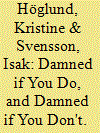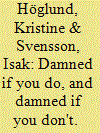| Srl | Item |
| 1 |
ID:
084349


|
|
|
|
|
| Publication |
2008.
|
| Summary/Abstract |
Third-party actors who mediate or monitor peace often strive to uphold an image of neutrality. Yet, they commonly face accusations of partiality. The Nordic engagement in the Sri Lankan peace process is an illustration of this puzzle: despite the efforts to uphold an image of being neutral mediators and monitors, they have been seen as favoring one side or the other. This article suggests that part of the explanation for their failure to be seen as neutral lies in the fact that armed conflicts are characterized by certain asymmetries between the main antagonists - in capabilities, status and behavior. These imbalances pose particular challenges to the third party aspiring to act in a neutral manner. We suggest that third parties have two strategies available to deal with imbalances in the relationship between the contenders: 1) they can choose to disregard the asymmetrical relationship and act in an even-handed manner or 2) they can seek to counterbalance the lopsidedness. This article explores the dynamics of these strategies by analyzing the Nordic involvement in Sri Lanka's peace process that began in 2002.
|
|
|
|
|
|
|
|
|
|
|
|
|
|
|
|
| 2 |
ID:
084485


|
|
|
|
|
| Publication |
2008.
|
| Summary/Abstract |
Third-party actors who mediate or monitor peace often strive to uphold an image of neutrality. Yet, they commonly face accusations of partiality. The Nordic engagement in the Sri Lankan peace process is an illustration of this puzzle: despite the efforts to uphold an image of being neutral mediators and monitors, they have been seen as favoring one side or the other. This article suggests that part of the explanation for their failure to be seen as neutral lies in the fact that armed conflicts are characterized by certain asymmetries between the main antagonists - in capabilities, status and behavior. These imbalances pose particular challenges to the third party aspiring to act in a neutral manner. We suggest that third parties have two strategies available to deal with imbalances in the relationship between the contenders: 1) they can choose to disregard the asymmetrical relationship and act in an even-handed manner or 2) they can seek to counterbalance the lopsidedness. This article explores the dynamics of these strategies by analyzing the Nordic involvement in Sri Lanka's peace process that began in 2002.
|
|
|
|
|
|
|
|
|
|
|
|
|
|
|
|
| 3 |
ID:
142610


|
|
|
|
|
| Summary/Abstract |
This article analyzes how the conflict environment in which a civilian monitoring mission is deployed influences the monitors' assessment of the operation. It draws on unique empirical material from the experience of the Sri Lanka Monitoring Mission (SLMM), deployed to oversee a ceasefire agreement in Sri Lanka 2002–2008. With material from a survey and in-depth interviews, experiences of the monitors are analyzed and changes over time are traced in relation to the monitors' assessment of the mandate and organizational set-up of the mission. The study points to the difficulty of monitoring missions to address escalation during an ongoing peace process. Its function is dependent on the goodwill of the parties. In essence, monitoring missions have the potential to strengthen peace when there is momentum in favor of progress, but when relations between the parties turn sour and the conflict escalates a civilian monitoring mission basically loses its potential. During the final stages of the war, which saw a very large number of civilian casualties, the war-torn areas were closed to international observers. Moreover, international pressure for a short-term ceasefire to alleviate the humanitarian situation was dismissed by the Sri Lankan government, which also saw the backing of several important actors, not the least China.
|
|
|
|
|
|
|
|
|
|
|
|
|
|
|
|